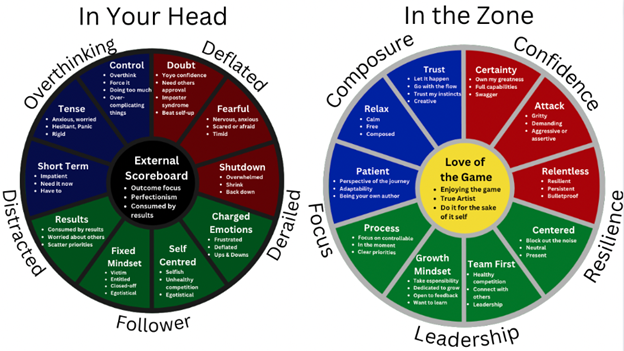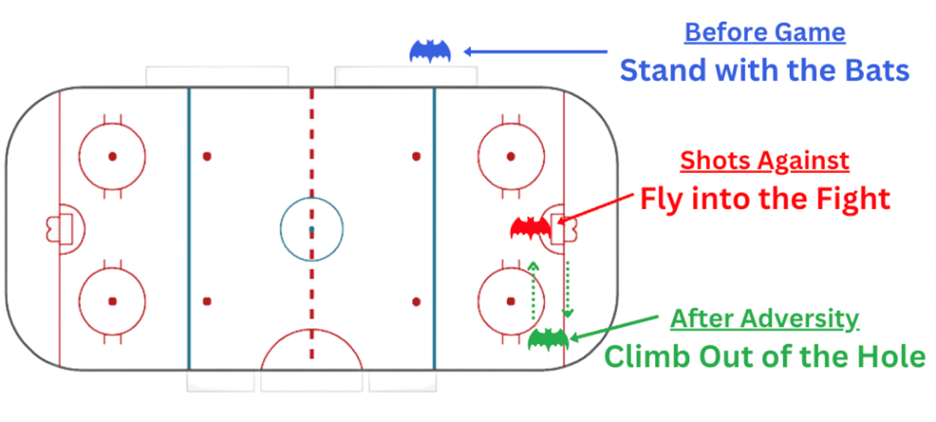If you want a sure fire way to quickly transform your mental game – you need to develop a personalized Alter Ego.
This strategy is not about putting fixed labels on who you are as a person.
Rather it is about creating a narrative about how you want to show up on the field of play.
The Power of Simplicity and Creativity
Credit to my coach and mentor Todd Herman for writing the book: The Alter Ego Effect and helping bring more simplicity and creativity to the mental game.
Unfortunately most sport psychology strategies are:
- Dry
- Boring
- Overcomplicated
As an athlete you don’t want to be out on the field of play trying to remember to use positive self talk, thought stopping, breathing exercises and re-framing situations.
These strategies won’t get you repeatable and reliable results, instead they just give you more things to think about, when what you need to do is think less.
You want to keep it simple and just play your game.
Therefore, you need practical and personalized strategies that work for you.
That’s exactly what you get in our 1-2 punch of the Reset Routine and Alter Ego.
Here are the 3 steps to creating a personalized Alter Ego:
STEP 1: Develop a Contrast
Think of the Alter Ego strategy as creating two contrasting narratives.
On one side you have your worst self, your shadow self, or your comfortable self. This is the self that holds you back, that plays safe, and that worries about what other people think.
On the other side you have your heroic self, your best self, or your courageous self. This is the self that embraces the moment, that is confident in their capabilities, and attacks the game.
My favorite way that Todd Herman explains these contrasting narratives is that the Heroic Self is the true-self while the Shadow Self is the false-self.
True-Self vs False-Self
A common misconception is your shadow self is the real you and you need to become your heroic self.
This is very limiting because you are seeing yourself and the real you as less than, and you need to add traits and become something you are not.
However, the reality is you have the heroic traits already within you and that is the true you.
Todd uses Superman and Clark Kent as an example. Who is the true-self vs the false-self? The reality is that Superman is always there and sometimes he ‘holds himself back’ to fit in or play small.
This is an important frame when doing this exercise. This makes your Alter Ego more about letting go of the limiting beliefs and the narratives holding you back so you can allow yourself to be the true version of yourself.
The next important part of developing this contrast is to identify the field of play and specifically the moments of impact.
The Moments of Impact
Identifying your key moments of impact is crucial to making your Alter Ego simple yet powerful.
You should pick 3 to 5 moments that have the biggest impact on your performance.
Examples of common key moments of impact for athletes include:
- Before the game – channeling your nerves
- Taking the big shot – being confident and letting it happen
- Transitioning to offense – getting into attack mode
- Dealing with adversity – bouncing back and staying resilient
- Creating offense – being creative yet having a killer instinct
- Playing defense – staying calm yet ferocious
For racing sports like swimming, biking, and running – the key moments are often broken up into their race plan, for example:
- Before the race – channel your nerves
- The start of the race – attack your race
- No man’s land – embrace the grind
- Preparing for the finish – commit to your plan
- The final stretch – relentlessly race your race
Note, this strategy can be transformative for other areas of life as well – whether you are a surgeon, a business executive, student, or parent – follow these steps to activate your best self in any area of life.
Contrasting Traits
Now that you have your three to five key moments of impact identified, you want to create contrasting traits for each of those key moments.
There are numerous ways to go about doing this. One of the more thorough and traditional ways is to break down the fundamental thoughts, feelings, focus, actions and results for both your heroic self and worst self in each moment of impact.
By flushing this all out you are creating a stark contrast from which you can identify the unique traits you don’t want versus the ones you do want in each moment of impact.
Performance Identity
Because we have done this exercise so many times we have been able to create a diagram representing the general make up for most high performance identities.
To be clear, no two Alter Egos or performance identities will be the same.
Each person will have a different variation in the moments of impact.
And even when two people might have the same moment of impact, how they want to show up in that moment will be unique.
So the diagram below is not meant to be used as a cookie cutter way to create your Alter Ego, but rather to help you quickly identify key traits and create a ‘balanced’ performance identity that works for you.
We use the word balance to help prevent you from over-indexing too much on any one trait or moment of impact.
For example, the diagram below has a blue side that represents being cool, calm and collected – the ice. Versus a red side that represents being competitive, confident and relentless – the fire. The ideal mindset always has a little combination of both Fire and Ice.
If you over-index on the fire and relentlessness, then you will likely burn too hot and not have the patience and adaptability needed for elite performance.
If you over-index on staying calm and collected, then you will likely be too cold and not have the competitiveness and relentlessness needed for elite performance.
Note the diagram uses the colour green to represent being centered and grounded. As well as yellow to represent the love of the game.

Again, this process should be personalized to both you and your key moments of impact.
The diagram above can be used to help you quickly and effectively identify your contrasting traits.
After clarifying your unique contrasting traits for each key moment of impact, then you are ready to move on to step two – being creative.
STEP 2: Be Creative
This is where the magic of the process comes out.
One of our most powerful tools as humans is our imagination.
When you personalize your Alter Ego with a sense of creativity and playfulness you optimize your ability to achieve Consistent Elite Performance.
It might seem a little weird, but you should try it out – because it works!
The goal of this step is to turn the two contrasting narratives from step 1 into a unique identity that clicks.
Superheroes and Inspiring People
The quickest way to get started is to think of your favorite superhero. If you don’t have one, then think of someone that inspires you – it could be a relative, famous athlete, public figure, or tv show character etc.
You might even have two or more people you lean on to help create your Alter Ego. The more creative and playful you are in this process – the better.
The person or people you pick should represent the traits you identified in step 1.
For example a hockey goalie that resonates with Batman could see the overlap as such:
- Before the game/the battle – he is calm and collected
- Taking shots against/in the fight – he is agile and trusts himself
- After adversity/gets knocked down – he gets back up
Tell a Story to Make it Click
The goal is to make the Alter Ego click for you – where you get this feeling “ah yah I get it.”
Stories are the best way to evoke this kind of emotion and feeling.
Create a story for each moment of impact to pull out your desired trait through your chosen superhero or inspiring person.
For instance, I’ll continue the goalie and Batman example:
| Key Moment of Impact | Story | Elaboration |
|---|---|---|
| Before the Game | I stand with the bats | Batman embraces his fear of bats and makes it his superpower. So instead of being afraid of goals against, I accept they happen. By doing this I stay calm and feel excited to play – not worried. |
| Shots Against | I spread my wings and fly into the fight | Batman spreads his wings, makes himself big, and flies into the fight. He trusts himself and attacks the opponent. So as a goalie I make myself big and smother the incoming shot. I trust my capabilities and let it happen. |
| After Adversity | I climb out of the whole | Batman shows great resilience and inner strength to climb out of the hole. He gets back up when he gets knocked down and keeps moving forward. So as a goalie if I get scored against or things are not going our way, I accept it and keep moving forward. |
The process personalizes your Alter Ego to a narrative that resonates with you.
Naming Your Alter Ego
Now that you have a narrative, you should creatively name both your heroic and worst-self Alter Egos.
The name helps summarize the narrative – it turns it into its own unique persona.
It can also be fun and helpful to create a tagline for your Alter Ego.
Again you should be creative, playful, and tap into the power of your imagination – there is no right or wrong way to do this.
One of the most famous and powerful examples is Kobe Bryant’s Alter Ego – The Black Mamba, which my mentor Todd Herman helped him create.
You want to be creative in the process just like Kobe. For example, one of my Olympic level kayakers created the Alter Ego the Lean Lion: with the tagline the Elk Killer. Her whole narrative and race plan is about the Lion attacking and chasing down the Elk.
Don’t forget to also name the worst-self Alter Ego. It helps personify the worst-self traits and narrative.
The contrast between your best-self versus your worst-self Alter Egos creates a clear choice for how you will show up at any given moment.
The Totem – Connecting it to Your Reset Routine
The last piece of being creative is choosing a totem to represent your Alter Ego.
Ideally this is tied into your personalized reset routine.
This helps further play on the power of your imagination and brings something tangible to help you activate your Alter Ego.
Specifically, as Todd Herman explains, the totem activates the power of clothed cognition. Which means wearing a piece of certain clothing helps activate the traits related to it.
For example give a kid a:
- Batman costume they become more resilient
- Lab coat they become more diligent
- Painters hat they become more creative
Select your favorite piece of equipment or a piece of jewelry you might wear with significant meaning to you – then associate it with your Alter Ego.
For example, a goalie might have a bat painted on his helmet – then they tap their helmet at the end of their reset routine to help activate their Alter Ego.
Check out the full video on creating a reset routine to combine these two strategies and create a powerful 1-2 punch.
STEP 3: Map It Out
The last step in creating your personalized Alter Ego is literally drawing it out on a map.
This step is crucial to simplifying your Alter Ego. You want to be able to boil it down so it is easy to understand yet still holds a powerful narrative that clicks for you.
Drawing it out on a map helps add another layer of tangibility to the process.
You can see clearly how you want to show up in the various key moments of impact on your field of play. You can color code it and use it as a cheat sheet summary of your Alter Ego.
The goal here is to keep it simple – it should not be over complicated or have too many words.
Here is map from the goalie and batman example we have been using:

The bottom line is you can get transformational results by adding simplicity and creativity to your mental game.
To summarize follow these 3 steps to create your personalized Alter Ego:
- Develop a Contrast
- Be Creative
- Map It Out
Please share this with anyone you think could benefit.
If you are interested in getting one of our Mental Performance Coaches to help you build your Alter Ego – just click the button below to get started.


 Nicholas is a Senior High-Performance Coach and holds a doctorate in Sport & Exercise Psychology. From his specialized psychology research program, to his PhD studies, Nicholas has gained a tremendous foundation of knowledge and appreciation for the human experience. His passion for psychology has accumulated to a commitment to studying and applying performance psychology and stoicism. This commitment has led Nicholas to conduct many research studies focusing on understanding why and how some people thrive and prosper while others do not. His admiration for evidence-based solutions has propelled Nicholas to produce studies revolving around mindfulness, grit (perseverance and passion), performance, quality participation, social relationships, and well-being.
Nicholas is a Senior High-Performance Coach and holds a doctorate in Sport & Exercise Psychology. From his specialized psychology research program, to his PhD studies, Nicholas has gained a tremendous foundation of knowledge and appreciation for the human experience. His passion for psychology has accumulated to a commitment to studying and applying performance psychology and stoicism. This commitment has led Nicholas to conduct many research studies focusing on understanding why and how some people thrive and prosper while others do not. His admiration for evidence-based solutions has propelled Nicholas to produce studies revolving around mindfulness, grit (perseverance and passion), performance, quality participation, social relationships, and well-being. A Native of Quebec, Sara was part of the St. Lawrence University Women’s Ice Hockey team that competed in the NCAA Division 1 hockey league ECAC. During this time, Sara helped her team appear in four ECAC Hockey Tournaments and two NCAA Frozen Fours, and was a four-time member of the ECAC Hockey All-Academic Squad. Following her career at St. Lawrence University, Sara played one year of professional hockey with Lugano, where she truly honed her skills in understanding the intricate connection between mindset and performance.
A Native of Quebec, Sara was part of the St. Lawrence University Women’s Ice Hockey team that competed in the NCAA Division 1 hockey league ECAC. During this time, Sara helped her team appear in four ECAC Hockey Tournaments and two NCAA Frozen Fours, and was a four-time member of the ECAC Hockey All-Academic Squad. Following her career at St. Lawrence University, Sara played one year of professional hockey with Lugano, where she truly honed her skills in understanding the intricate connection between mindset and performance.
 Blair has over 13 years of experience as a Professional Dancer, Assistant Dance Captain & Cast Manager, as well as an additional 17 years of training. Over the last 3 decades, she has lived and experienced first hand the highest of highs & lowest of lows that come with pursuing a career in the Performing Arts.
Blair has over 13 years of experience as a Professional Dancer, Assistant Dance Captain & Cast Manager, as well as an additional 17 years of training. Over the last 3 decades, she has lived and experienced first hand the highest of highs & lowest of lows that come with pursuing a career in the Performing Arts.

 Natasha Habert draws from her training in sport and performance psychology, personal experiences as a competitive athlete, and deep passion for consistent high performance. She is a lifelong athlete and high performer, excelling in volleyball as both a player and coach.
Natasha Habert draws from her training in sport and performance psychology, personal experiences as a competitive athlete, and deep passion for consistent high performance. She is a lifelong athlete and high performer, excelling in volleyball as both a player and coach. Luciano’s hockey career is highlighted by his time playing college at the University of Victoria and two professional seasons in Europe. Throughout his career, he struggled with performance anxiety, a lack of consistency, fluctuations in confidence, and being caught in the results trap. This eventually led him to deviate from the main reason why anyone should play sports – for the enjoyment of the game. As a former athlete, Luciano has a unique understanding of the psychological pressures and struggles that athletes experience.
Luciano’s hockey career is highlighted by his time playing college at the University of Victoria and two professional seasons in Europe. Throughout his career, he struggled with performance anxiety, a lack of consistency, fluctuations in confidence, and being caught in the results trap. This eventually led him to deviate from the main reason why anyone should play sports – for the enjoyment of the game. As a former athlete, Luciano has a unique understanding of the psychological pressures and struggles that athletes experience. Alexis Woloschuk is a name synonymous with mental fortitude in the world of professional hockey. Throughout her career originating playing boys hockey, going to an academy away from home, playing her four years at Boston University and 7+ years in pro hockey she’s learned the importance of resilience, confidence, and dismissing both fear and other’s opinions. With a blend of relatability, confidence, and an acute understanding of playing to one’s potential, Alexis helps athletes reshape the way they perceive and harness the power of their minds.
Alexis Woloschuk is a name synonymous with mental fortitude in the world of professional hockey. Throughout her career originating playing boys hockey, going to an academy away from home, playing her four years at Boston University and 7+ years in pro hockey she’s learned the importance of resilience, confidence, and dismissing both fear and other’s opinions. With a blend of relatability, confidence, and an acute understanding of playing to one’s potential, Alexis helps athletes reshape the way they perceive and harness the power of their minds. Sean Mahoney is a member of the Association for Applied Sport Psychology (AASP), and a Master’s candidate in the Sport and Performance Psychology program at the University of Denver. For as long as he can remember, Sean has been fascinated by human performance and how to gain an edge over the competition. For most of his athletic career, he focused on the physical aspect of performance but neglected the mental. Because of this, he struggled with performance anxiety, focus issues, and limiting beliefs pertaining to confidence and self-doubt. His lack of focus on optimizing his mental game prevented him from reaching his full potential.
Sean Mahoney is a member of the Association for Applied Sport Psychology (AASP), and a Master’s candidate in the Sport and Performance Psychology program at the University of Denver. For as long as he can remember, Sean has been fascinated by human performance and how to gain an edge over the competition. For most of his athletic career, he focused on the physical aspect of performance but neglected the mental. Because of this, he struggled with performance anxiety, focus issues, and limiting beliefs pertaining to confidence and self-doubt. His lack of focus on optimizing his mental game prevented him from reaching his full potential. Savannah Fitzgerald is earning her M.A. in Kinesiology, Sport Psychology Option at California State University, Fresno. Possessing an internal motor that fires her rage for success, Savannah forged this attribute over five years while competing as an NCAA D-I water polo player and swimmer. Combined with her opportunity to represent and compete for the United States, she feels that sport has significantly impacted her professional development. Due to her personal experience playing at all levels, Savannah’s passion for mental performance began when she struggled to overcome pre-competition nerves and post-competition processing. When she discovered a world out there that people were referring to as ‘sport psychology,’ she felt like a piece of her brain was unlocked. Reality shifted as she stumbled into a space consisting of the most beautiful blend of elite performance, mental well-being, and athletics.
Savannah Fitzgerald is earning her M.A. in Kinesiology, Sport Psychology Option at California State University, Fresno. Possessing an internal motor that fires her rage for success, Savannah forged this attribute over five years while competing as an NCAA D-I water polo player and swimmer. Combined with her opportunity to represent and compete for the United States, she feels that sport has significantly impacted her professional development. Due to her personal experience playing at all levels, Savannah’s passion for mental performance began when she struggled to overcome pre-competition nerves and post-competition processing. When she discovered a world out there that people were referring to as ‘sport psychology,’ she felt like a piece of her brain was unlocked. Reality shifted as she stumbled into a space consisting of the most beautiful blend of elite performance, mental well-being, and athletics. Gabe is currently completing his Master’s in Counselling Psychology at the University of Victoria. Although Gabe played several years of high-level baseball, including a stint in the British Columbia Premier Baseball League (BCPBL), he chose hockey as his sport to pursue at the highest level possible. Gabe went on to play four years of junior hockey with the Richmond Sockeyes in the Pacific Junior Hockey League (PJHL) while also coaching minor hockey. Prior to junior hockey, Gabe played 3 years in the Canadian Sport School Hockey League (CSSHL) where he experienced the pressures and expectations of moving on to the next level. During those three years, Gabe constantly compared himself to others and struggled with coping when things did not go his way. Over time, he learned how to focus on his own process and path to the next level, while also developing strategies to improve well-being.
Gabe is currently completing his Master’s in Counselling Psychology at the University of Victoria. Although Gabe played several years of high-level baseball, including a stint in the British Columbia Premier Baseball League (BCPBL), he chose hockey as his sport to pursue at the highest level possible. Gabe went on to play four years of junior hockey with the Richmond Sockeyes in the Pacific Junior Hockey League (PJHL) while also coaching minor hockey. Prior to junior hockey, Gabe played 3 years in the Canadian Sport School Hockey League (CSSHL) where he experienced the pressures and expectations of moving on to the next level. During those three years, Gabe constantly compared himself to others and struggled with coping when things did not go his way. Over time, he learned how to focus on his own process and path to the next level, while also developing strategies to improve well-being. Louie is a mental performance coach from Toronto, Canada with a professional hockey career spanning over 14 years. Being a standout player at the University of Michigan, Louie was a Hobey Baker finalist and a 1st team All-American, which led him to getting drafted by the Ottawa Senators and playing in renowned leagues across the globe, including the DEL, SHL, and AHL.
Louie is a mental performance coach from Toronto, Canada with a professional hockey career spanning over 14 years. Being a standout player at the University of Michigan, Louie was a Hobey Baker finalist and a 1st team All-American, which led him to getting drafted by the Ottawa Senators and playing in renowned leagues across the globe, including the DEL, SHL, and AHL.
 Mia Landry is a former varsity hockey player at Brock University, where she competed at the USPORT level and was part of the 2021-22 OUA gold medal team. Mia currently represents Canada on the Women’s National Ball Hockey team and is pursuing a Master of Kinesiology Sport Psychology at her alma mater. Her research focuses on areas such as team cohesion, group dynamics, leadership styles, and sports culture.
Mia Landry is a former varsity hockey player at Brock University, where she competed at the USPORT level and was part of the 2021-22 OUA gold medal team. Mia currently represents Canada on the Women’s National Ball Hockey team and is pursuing a Master of Kinesiology Sport Psychology at her alma mater. Her research focuses on areas such as team cohesion, group dynamics, leadership styles, and sports culture. As a former member of McMaster University’s women’s soccer team, Emilie intimately understands the demands and challenges athletes face on and off the field. Although she encountered many challenges as a high-level athlete, particularly struggling with self-doubt and overthinking, Emilie was able to make a remarkable transformation when she began to embrace the principles of sports psychology.
As a former member of McMaster University’s women’s soccer team, Emilie intimately understands the demands and challenges athletes face on and off the field. Although she encountered many challenges as a high-level athlete, particularly struggling with self-doubt and overthinking, Emilie was able to make a remarkable transformation when she began to embrace the principles of sports psychology. Max is currently attending William James College, where he is earning a Doctorate Degree in Clinical Psychology and a Masters Degree in Professional Psychology. During his time as an undergraduate student, Max was inducted into the International Honor Society in Psychology (Psi Chi), and played on the Quinnipiac University men’s club ice hockey team.
Max is currently attending William James College, where he is earning a Doctorate Degree in Clinical Psychology and a Masters Degree in Professional Psychology. During his time as an undergraduate student, Max was inducted into the International Honor Society in Psychology (Psi Chi), and played on the Quinnipiac University men’s club ice hockey team.







